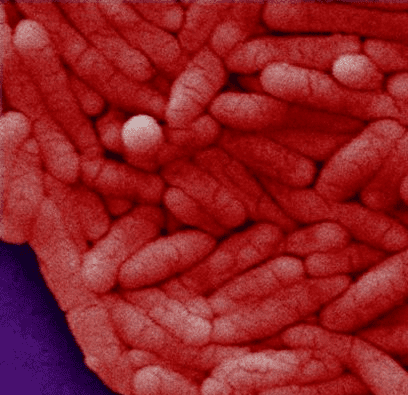The body’s innate immune system is a first line of defense, intent on sensing invading pathogens and wiping them out before they can cause harm. It should not be surprising then that bacteria have evolved many ways to specifically evade and overcome this sentry system in order to spread infection.
A study led by researchers in the University of Pennsylvania’s School of Veterinary Medicine now reveals how some Salmonella bacteria hide from the immune system, allowing them to persist and cause systemic infection. The findings could help researchers craft a more effective vaccine against Salmonella.
Igor Brodsky, an assistant professor in Penn Vet’s Department of Pathobiology, was senior author on the paper, which was published in the Journal of Experimental Medicine.
“Many of the same signals that are present in harmless bacteria are also present in pathogenic bacteria,” Brodsky said. “One of the big unanswered questions is how does the innate immune system distinguish between the two? And, conversely, how have pathogenic bacteria evolved to get around the immune response?”
Focus on Inflammasome
The Penn study addresses both questions, focusing on a component of the innate immune response called the inflammasome. Consisting of a complex of proteins that triggers the release of signaling molecules, the inflammasome serves to recruit other components of the immune system that can fight off the pathogen.
“We hypothesized that during the systemic phase of disease, Salmonella would have some way of avoiding inflammasome activation,” Brodsky said.
To identify the mechanism by which the bacteria might do this, Brodsky’s team made a library of Salmonella mutants, looking for those that might be involved in the evasion strategy.
Among the 18 genes they pinpointed were four that had been previously noted to have a role in enabling Salmonella strains to cause long-term, chronic infections.
“That was interesting because it suggested that at least a subset of those genes that might be important for long-term infection might be involved in evading or suppressing the inflammasome response,” Brodsky said.
They trained their attention on one of these four, the gene that encodes the enzyme aconitase. Aconitase, which converts citrate to isocitrate, is a key component in the metabolic process known as the citric acid or Krebs cycle. This cycle is used by all oxygen-breathing organisms to convert sugar into energy and to produce important molecules for cell growth.
When the aconitase gene was mutated, the inflammasome known as NLRP3 was highly activated, leading researchers to believe that the normal version of aconitase might do the opposite, inhibiting the inflammasome. Moreover, when the researchers infected mice with a strain of Salmonella that had a mutated version of aconitase, the rodents were able to clear the infection, likely due to the inflammasome being activated. This infection led to increased levels of inflammation in the mice’s tissues.
Trigerring Inflammatory Response with Citrate
The Penn-led team also wanted to see whether other components of the citric acid cycle might be involved in inflammasome activation. They found that mutating Salmonella genes that encode two other players in the cycle, the enzymes isocitrate dehydrogenase and isocitrate lyase, also led to higher activation of the NLRP3 inflammasome.
In their normal state, these enzymes break down citrate. Thus the study’s results point to the possibility that the immune system may activate the inflammasome in response to the presence of citrate or some byproduct of citrate. Supporting this idea, the researchers found that Salmonella strains lacking the enzyme citrate synthase, which produces citrate, led to a reduced inflammatory response.
“We think bacteria might be exporting citrate because it would otherwise prevent the bacteria from growing,” Brodsky said. “It’s possible that the export of citrate might be triggering the inflammatory response. Our work fits into this emerging idea that bacterial metabolites might be recognized by various components of the immune system for the purpose of either negatively or positively regulating immune responses.”
The scientists believe that it’s possible that host cells put together two pieces of information to trigger an immune response, first recognizing signaling of a Toll-like receptor, which responds to structures that are common across many microbes, and then sensing bacterial products, like elevated levels of citrate, being produced inside the cell itself.
Brodsky and colleagues are now working to develop a chicken vaccine based on an attenuated strain of Salmonella that would trigger both “arms” of the inflammatory response, possibly involving an aconitase mutant. Such a vaccine would ideally more closely replicate a natural infection, protecting the animals against infection.
“We get Salmonella from chickens that are chronically infected,” Brodsky said, “so, if you could prevent or limit chronic infection of chickens, that would be a nice way to limit Salmonella in the food supply.”
Co-authors included Penn Vet postdoctoral associates Meghan A. Wynosky-Dolfi and Patrick J. Doonan, Ph.D. students Naomi H. Philip, Erin E. Zwack and Amber M. Riblett and department colleague Bruce D. Freedman. The Penn researchers collaborated with Till Strowig and Richard A. Flavell of Yale University School of Medicine and Maya C. Poffenberger, Daina Avizonis and Russell G. Jones of McGill University.
Read the study at the Journal of Experimental Medicine: Oxidative metabolism enables Salmonella evasion of the NLRP3 inflammasome.



